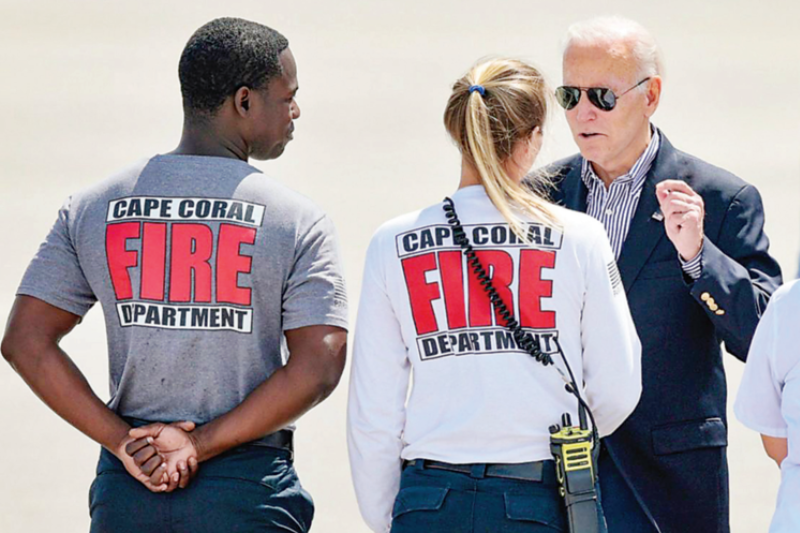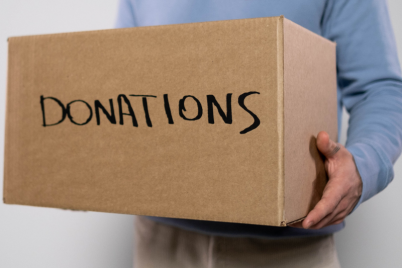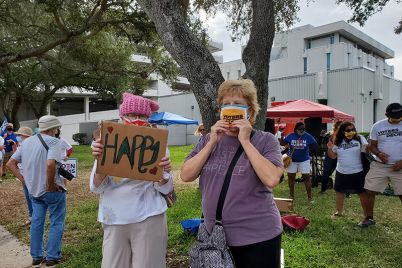President Joe Biden speaks to Cape Coral firefighters during his visit to Fort Myers on Oct. 5. AL DIAZ | MIAMI HERALD | TNS
BY KARIN DAVIS THOMPSON, Florida Courier
As President Joe Biden prepared to visit areas in Fort Myers devastated by Hurricane Ian on Wednesday, Oct. 5, residents in several historically Black neighborhoods in Southwest Florida weren’t holding out much hope that help was coming quickly for them.
Shannon Tolbert, a resident in Dunbar, a historically Black neighborhood in Fort Myers, told USA Today days after the storm that she and her cousins were still waiting for power to the neighborhood. On Friday, Sept. 30, they decided to try and cool off in their SUV.
“Every time we have a storm, we’re the last ones to get power,” said Tolbert’s cousin, Valorie Simmons.

Residents in communities of color say hurricane assistance is painfully slow. Pictured above, Warren Adkins, left, and other River Park residents evacuating during the storm. Photo courtesy of Leona Adkins
Simmons has lived in Dunbar her entire life and said they aren’t surprised that they are still waiting.
“It’s expected,” she said. “Where it’s Black and brown people… we get it last.”
Residents said they fear they will once again have to wait in the aftermath as their wealthier white neighbors in the area get first priority.
Residents have shared their concerns with media outlets and with government officials but say help is still slow in coming.
Last Tuesday, Governor Ron DeSantis’ office issued a statement about recovery efforts in Fort Myers, including that additional resources had been deployed to support the Dunbar community.
Plea for help in Collier County
In Collier County, the local NAACP spoke with officials on behalf of residents in River Park.
The community is less than a 20-minute drive to the beach and is comprised of only three streets of houses and a few apartment complexes, inhabited mainly by African Americans who have been there for decades.
Leona Adkins and her husband, Warren, own one of the houses, nearly destroyed from several feet of flooding that devastated the area last week.
She and her family have been staying in hotels. They spend their days cleaning up their home and assisting other needy neighbors. They say what they need most is a safe place to live and help getting their homes livable again.
Unfortunately, many residents have been forced to stay in their homes with soiled furnishings, no power and sewage backup because there’s nowhere else for them to go. Shelters were not immediately made available after the storm, and there aren’t many hotels. Affordable housing in Naples doesn’t really exist.
“My toughest battle is asking for help. We have literally lost EVERYTHING. My home was my family’s safe place that is now in desperate need of repair,” Adkins wrote in a GoFundMe post she set up on Oct. 3. “My husband and I work hard and care for my elderly aunt and grandchildren, who have all now been separated. At this time, our ‘home’ is no longer that. We are seeking a short-term lease (waiting for home repairs) with no luck.
“At this time, we don’t own any of the things that we worked so hard for, but we do have our lives. Our home has housed and provided food and shelter for many throughout the years. We are not asking for handouts; we are asking for help,” she related.
Adkins, a family resource advisor in Collier County, said information about a shelter was distributed in the area on Oct. 4, and donations were coming in.
“A lot of hot food is being distributed as well as water and snacks, fresh fruit,’’ she told the Courier.
‘We’re destroyed, too’
NPR interviewed Black residents who said that while some news outlets are reporting on their struggle, most have spent more time covering more affluent areas in Naples and Fort Myers, including Sanibel Island and Fort Myers Beach.
“They’re saying the islands got destroyed,” Lexxus Cherry, who lives in the Dunbar community, told NPR. “Well, we’re destroyed, too. We’re really messed up here.”
As in the River Park neighborhood and other hard-hit communities, Dunbar residents were coping with a lack of power, unsafe drinking water and sewage backups.
Officials have told residents that their first priority was to protect life but that they hear the frustration of the Black and brown communities.
But people in the community aren’t convinced, and they have begun to do what they always do, rely on each other and the kindness of others to get through.
Relying on each other
The Collier County NAACP, local churches, organizations and individuals have been in the area daily since the hurricane, providing food, clothing and other donations. The local NAACP is accepting financial contributions to help River Park residents through its website, NAACPCollier.org.
Residents who don’t live in the area, like Shazi Parker, also have been in the neighborhood daily to provide support.
“People are coming in in numbers. I have never seen so much support in that community,’’ Parker told the Courier.
Parker, who works at a city recreation center in River Park, has been shopping for clothes for children who live in the area. The children were scheduled to return to school on last Thursday. She’s appreciative of the clothing donations but wanted to provide the kids with new items.
“I don’t want kids going back to school with hand-me-downs. They need to go back with something fresh because they’re already going through enough,’’ she said. She’s also collecting school supplies.
As of Oct. 6, there have been 92 Florida deaths reported, and about 400,000 residents in Florida remain without power.
The president’s visit
Last Wednesday, Deanne Criswell, FEMA’s administrator, traveled with President Joe Biden to Fort Myers to survey some of the heavily damaged areas there. They also met with DeSantis and response officials about ongoing efforts to help survivors and hard-hit communities in Florida and met some residents impacted by the storm.
“I wanted to tell you in person that we’re thinking of you, and we’re not leaving. We’re not leaving until this gets done. I promise you that,” Biden said during a press conference at Fort Myers’ Fisherman’s Wharf.
In a statement issued on Oct 5, FEMA said it already has registered hundreds of thousands of households of Floridians and continues going door to door in 11 counties assisting with applications and answering questions about the types of federal assistance available.
FEMA also reports approving more than $70 million for Florida residents to help jumpstart recovery efforts.
“Right now, we are focused on meeting the immediate needs of survivors impacted by Hurricane Ian while reducing barriers and increasing opportunities so all people, including those from vulnerable and underserved communities, can better access FEMA assistance,” Jeremy M. Edwards, FEMA’s press secretary, told the Courier last Wednesday.
“Under the leadership of Administrator Criswell, we have undertaken a number of initiatives to expand access, so more people are better able to access our recovery and resilience programs. This includes expanding documentation survivors can provide to verify home occupancy and ownership. We will continue to support the people of Florida and do everything in our power to jumpstart their road to recovery.”
FEMA also has opened Disaster Recovery Centers, offices staffed by state, federal, and volunteer organizations where residents can access recovery information.
In addition, homeowners in Charlotte and Lee Counties can now sign up for Operation Blue Roof, a program managed by the U.S. Army Corps of Engineers that provides homeowners with fiber-reinforced sheeting to cover their damaged roofs until repairs can be made.
For more information on Operation Blue roof, call 888-ROOF-BLU.
To learn more about additional programs or to apply for FEMA assistance, go to disasterassistance.gov or call 800-621-3362.









